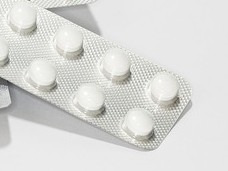DALLAS � December 2002 � Longer dialysis treatment and use of a highly permeable artificial kidney may not improve survival rates or reduce hospitalization of patients with end-stage kidney disease, a researcher at UT Southwestern Medical Center at Dallas has discovered.
Subgroup analyses suggest a higher dose of hemodialysis (blood passed through an artificial kidney to remove waste products and toxins) may improve survival in women, however, and a more permeable membrane may reduce the risk for cardiovascular complications in patients on hemodialysis.
The findings appear in the Dec. 19 issue of The New England Journal of Medicine.
"The importance of this study is that it is the first prospectively designed study to evaluate what happens when you apply higher doses of dialysis and highly permeable artificial kidneys in a clinical trial," said Dr. Robert Toto, professor of internal medicine and senior author of the study. "We learned a higher dose of dialysis and a higher permeable membrane is not enough. We've got to do better. We've got to do more to help improve the quality and duration of life of patients on hemodialysis."
UT Southwestern was among 15 U.S. clinical centers participating in a randomized trial of about 1,850 patients with severe kidney failure who required hemodialysis. The objectives of the Hemodialysis Study, designed in 1994, were to determine if a high dose of dialysis is better than a standard dose and whether dialysis with a highly permeable artificial kidney benefits patients on hemodialysis for end-stage kidney disease (ESKD), both in improving survival and reducing hospitalization.
Continue Reading Below ↓↓↓
ESKD, Toto said, is a condition in which kidney failure is so severe that death occurs unless kidney function is replaced by either dialysis or transplantation. It is increasing in the United States, and morbidity and mortality of ESKD patients is high, even for those on dialysis.
"If you take all patients in the United States on dialysis, about 60 percent die from either heart disease or stroke," said Toto, director of clinical nephrology and patient-oriented research in nephrology. "Cardiovascular disease is what causes many of these patients to die."
People requiring dialysis usually undergo hemodialysis three times a week, Toto said, and each session lasts approximately three hours. Through the Hemodialysis Study, patients were provided a higher dose of dialysis by adjusting the overall treatment time, the type of artificial kidney, or the blood flow rate through the artificial kidney. Any or all three variables were modified. Patients treated at the greater dose of hemodialysis averaged 32 percent more dialysis than the standard dose.
Afterward, the researchers found no improvement in survival or hospitalization in patients treated with a higher dose of dialysis or a more permeable membrane. Previous observational studies have reported continuing improvement in morbidity and mortality at dialysis doses well above those recommended in the current national guidelines, but other studies have not supported these findings.
Although the study found no improvement in mortality for dialysis patients overall, selected subgroups of patients may derive benefits from a higher dose of dialysis or a more permeable membrane. Deaths and hospitalization from heart disease were significantly lower in those treated with the more permeable membrane, and the mortality rate for women receiving higher doses was 19 percent lower than the women receiving the standard dose.
"The Hemodialysis Study completed by Dr. Toto and his colleagues and published in The New England Journal of Medicine represents a landmark study," said Dr. Peter Igarashi, chief of nephrology and professor of internal medicine at UT Southwestern.
"More than 250,000 Americans are receiving hemodialysis for treatment of end-stage kidney disease, and this study is the first major clinical study of dialysis patients in more than 20 years," said Igarashi. "The study indicates that for the total population the current practice of thrice-weekly treatment is not improved with a higher dose of dialysis or more porous artificial kidney. Other modifications, such as more frequent treatments or overnight dialysis, may be needed."
Overall, the five-year survival rate on hemodialysis in the U.S. dialysis population is about 45 percent, Toto said. The reasons for this high mortality rate are not fully known, but the increase in type 2 diabetes is believed to be a significant factor.
In America, about 45 percent of new patients going on dialysis are diabetic, about a third of existing cases involve diabetics, and diabetics have more severe diseases in general than non-diabetics. Almost 90 percent of new ESKD patients also have high blood pressure.
"The dose of dialysis is only one variable of the many that can affect the outcome of patients with kidney failure," Toto said.
Continue Reading Below ↓↓↓
The Hemodialysis Study was sponsored by the National Institutes of Health, the National Institutes of Diabetes and Digestive and Kidney Diseases (NIDDK), Baxter Healthcare, Fresenius Medical Care, R&D Laboratories, Ross Laboratories, Amgen, Vasca LifeSite Trial, and Eli Lilly.
Other researchers on the study were from NIDDK; Baylor College of Medicine, Houston; the Cleveland Clinic Foundation; the University of Utah and the Veterans Affairs Salt Lake City Health Care System; the University of Illinois and the Veterans Affairs Chicago Health Care System; the University of Alabama at Birmingham; Emory University Hospital, Atlanta; Washington University, St. Louis; the University of California at Davis, Sacramento; New England Medical Center, Boston; Beth Israel Medical Center, New York; Brigham and Women's Hospital, Boston; the University of Rochester; Wake Forest University; Vanderbilt University; Duke University; and Lankenau Hospital and Medical Research Center, Wynnewood, Pa.
Source: University of Texas Southwestern Medical Center at Dallas











